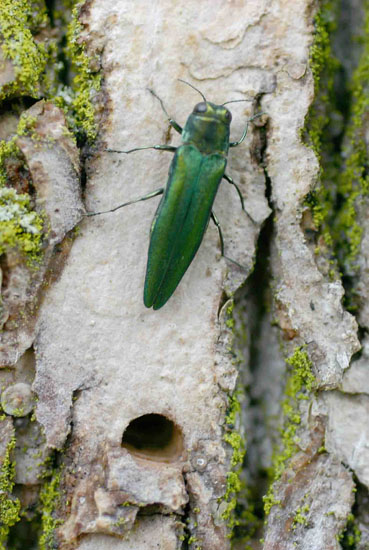Issue 3, May 14, 2018
Emerald Ash Borer Adults Emergence
Emerald ash borer activity should be under way in the southern part of the state and we expect activity to begin in central Illinois soon. Adult emergence generally begins with the accumulation of 450-500 degree-days.
Emerald Ash Borer |
Base 50°F |
Biofix = March 1 |
|
|---|---|---|---|
|
|||
Accumulated Degree-Days |
Generation |
Stage |
General Activity |
450-500 |
1 |
Adult Emergence |
Foliage Feeding |
1000 |
1 |
Peak Activity |
Mating |
Table 1. Degree-days and corresponding emerald ash borer activity. | |||
Station Location |
Actual Total |
One- Week Projection |
Two-Week Projection |
|---|---|---|---|
Freeport |
252 |
323 |
398 |
St. Charles |
267 |
333 |
402 |
DeKalb |
233 |
310 |
391 |
Monmouth |
322 |
407 |
491 |
Peoria |
343 |
430 |
515 |
Champaign |
371 |
461 |
552 |
Springfield |
461 |
561 |
662 |
Perry |
471 |
562 |
652 |
Brownstown |
443 |
545 |
651 |
Belleville |
476 |
582 |
692 |
Rend Lake |
506 |
617 |
733 |
Carbondale |
475 |
578 |
688 |
Dixon Springs |
537 |
647 |
762 |
Table 2. Degree-days and projected degree-day accumulations for the emerald ash borer. | |||
Retired, University of Illinois Extension Entomologist shared this information on the importance of emerald ash borer adult emergence and their management at this time last year:

Now is the time to apply systemic insecticides to control this pest if emerald ash borer has been found within 15 miles. The systemic insecticides azadirachtin (Azatin), dinotefuran (Safari), emamectin benzoate (Tree-Age), and imidacloprid (Merit), provide excellent control of emerald ash borer by killing adults feeding on ash leaves. This is probably the major method of control with the exception of emamectin benzoate which has been shown to also be very effective in killing larvae within the tree.
Many female beetles rely on leaf-feeding after emergence to mature their ovaries prior to egg production. It is likely that male beetles benefit by leaf-feeding as well. Although emerald ash borer beetles can fly one-half-mile or more, it appears that they do not fly as far if suitable hosts are close at hand. Long-distance flights apparently are most common when an area's trees are heavily infested.
Heavily damaged, untreated trees are likely to produce large numbers of beetles that are likely to fly to nearby healthy, treated trees. However, because heavily damaged trees typically have few leaves, those flying to treated trees are likely to feed on the treated trees' leaves and be killed before laying eggs. This is borne out by many instances of healthy, treated trees surviving while nearby untreated trees die.
Pollinating insects generally do not visit wind-pollinated trees such as ash. The pollen of wind-pollinated plants typically does not contain the high protein content found in pollen of insect-pollinated plants. However, ash produces large quantities of pollen when local higher quality sources such as dandelion and other spring flowers might not be present. When this occurs, up to 30% of the pollen collected by honey bees during this time has been found to be ash. Because systemic insecticides are likely to enter pollen, we recommend treating after ash leaflets have expanded to at least three-quarters of full size. By that time, ash have completed pollination, greatly reducing the potential of harm to honey bees and other pollinators. Three-quarter leaflet expansion has occurred in southern and central Illinois.
Also important to note –, while EAB is http://hyg.ipm.illinois.edu/article.php?id=853deregulated in the state, we are still interested in where this insect is being found. Sixty-four counties have been confirmed positive for emerald ash borer in Illinois. We encourage the reporting of EAB in counties where it is not known to occur. This can be done by contacting your local Extension office or the Illinois Department of Agriculture. (Kelly Estes)
Author:
Kelly Estes